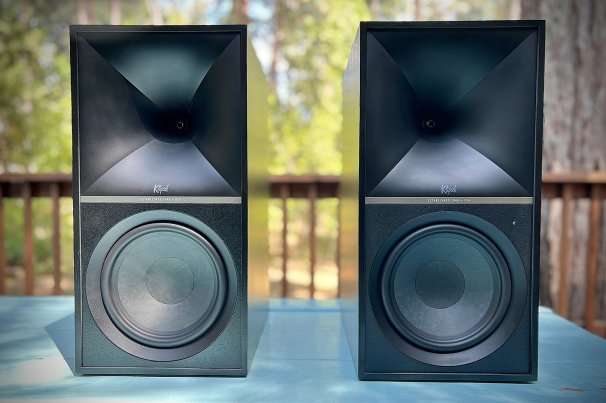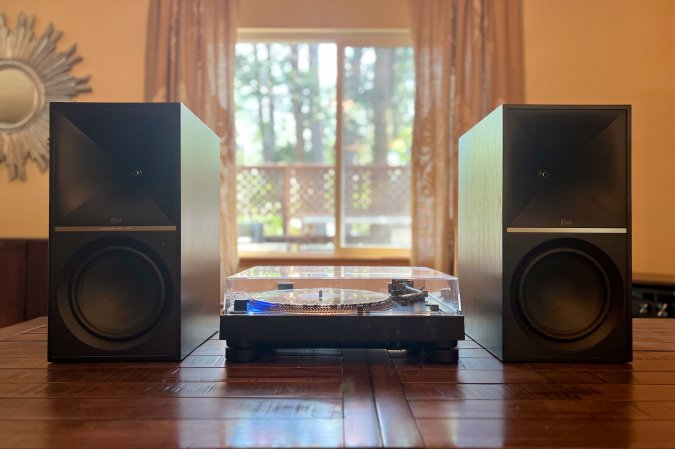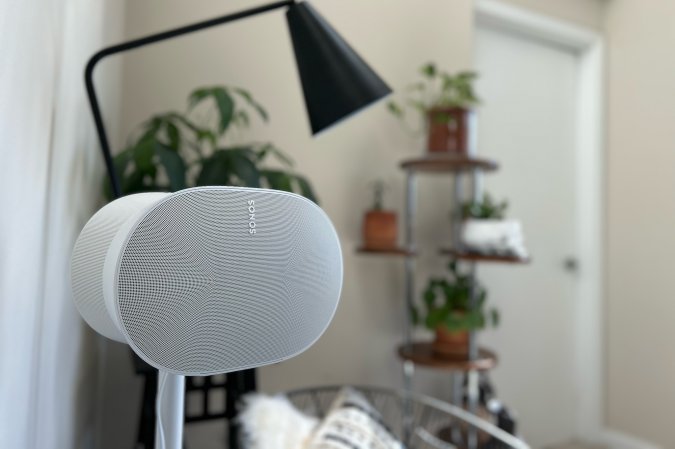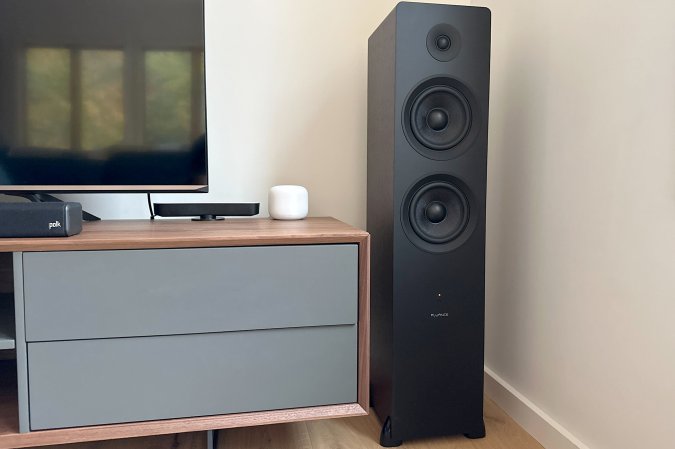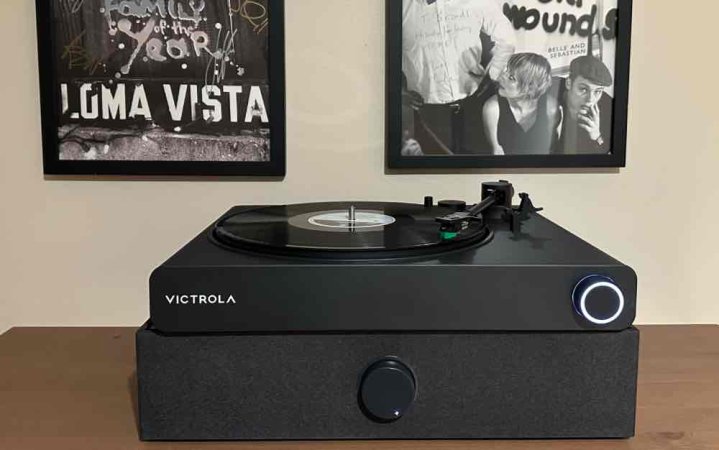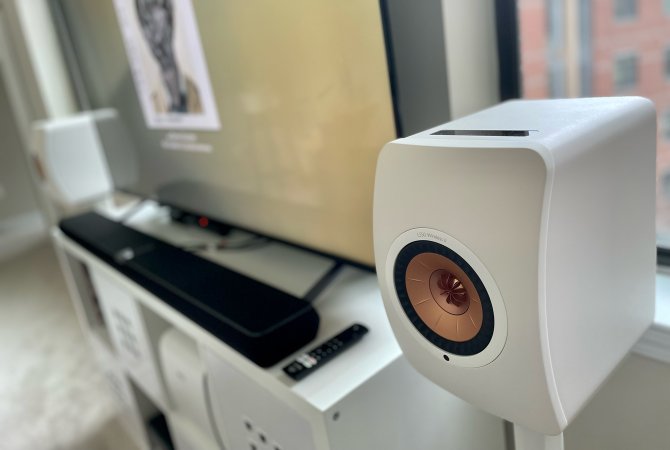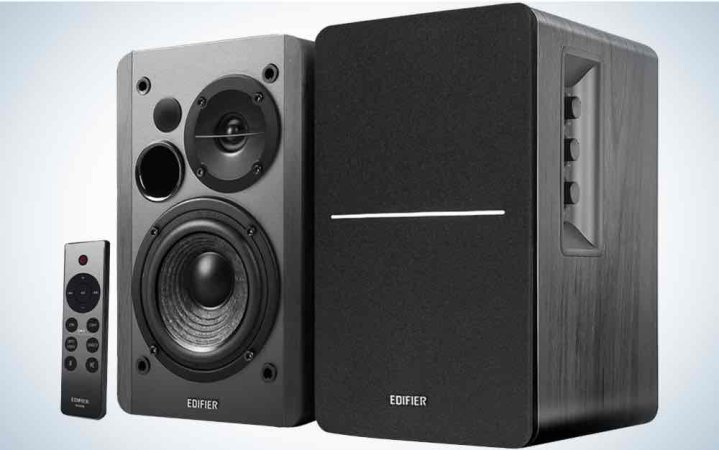We may earn revenue from the products available on this page and participate in affiliate programs. Learn more ›
If you’ve finally decided to give vinyl a shot (or want to dust off your old collection), you’ll need to hook your turntable up to a good pair of speakers. To truly experience sonic excellence, every link in your audio chain must perform as well as possible. The good news is that, with a little forethought and the right components, you can hook a record player up to any set of speakers. The bad news is all those options can introduce choice paralysis and make you get in the weeds on things like drivers and speaker wires. Don’t worry, however, as we’ve done thorough research and testing to identify the best turntable speakers—such as our best overall pick, the Klipsch The Nines—to buy right now.
- Best overall: Klipsch The Nines
- Best smart: Sonos Era 300
- Best floorstanding: Fluance Ai81 Elite
- Best compact: Andover Audio Spinbase MAX
- Best bookshelf: PSB Alpha iQ Streaming Powered Speakers
- Best passive: KEF LS50 Meta
- Best budget: Edifier R1280DBs
How we chose the best turntable speakers
The reporters at PopSci take audio quality very seriously. We also want to make the journey of finding the right turntable and everything associated with it as simple as possible for you. Yes, we’ll dive into some nerdy speaker specs for those who want it, but our approach was to make our findings digestible for anybody. We factored in everything from price to the size of your room and other equipment you may or may not want in your audio setup. Want the connectivity and processing of an AV receiver? That’s perfectly fine. Live in a small space? We have you covered. Want to use the same set of speakers for both analog and digital equipment? Sure thing. Chances are you’re not going to replace or upgrade your turntable speakers frequently, so it’s important to consider your current and future needs to select the right pair.
The best turntable speakers: Reviews & Recommendations
Choosing turntable speakers is all about getting the best sound from your records. That simple axiom should be your North Star while choosing speakers, the same way it was for us during our tests and research. Our recommendations cover the spectrum of cost, connectivity options, shapes, and sizes, so anyone can find a pair they can be happy with.
Best overall: Klipsch The Nines
Pros
- Concert-like sound
- Suitable for turntables and high-res audio files
- Built-in phono preamp
Cons
- Cost
Specs
- Dimensions: 13.38 x 9.5 x 19.13 inches
- Powered: Yes
- Drivers: 1-inch titanium tweeters on Tractrix horns, 8-inch woofer
- Ports: 1 x RCA, 1 x USB, 1 x Optical, 1 x AUX, 1 x HDMI, 1 x Subwoofer out
- Bluetooth: Yes
- Price: $1,499 MSRP (Pair)
Want a set of speakers with a connection panel dressed to the nines? That’s not why Klipsch named its latest set of powered speakers (it’s because the Nines are bigger than the Fives and the Sevens), but it’s fitting. And during our time with the Nines, we found Klipsch knocked it out of the park.
Our tests included hooking the speakers up to an Audio-Technica AT-LP140XP direct-drive turntable. While the speakers’ built-in preamp was bested by a standalone ART DJ Pre II phono preamp, we found the convenience of using The Nines as-is to be very compelling. We’re also fans of these speakers’ grounding peg, so your music won’t have to compete with an annoying hum. In our listening area—a 15×20-foot room—the speakers filled the room with well-balanced sound. Though it has a subwoofer output, we never considered plugging one in thanks to the bass response of each speaker’s massive woofer. While they worked well out of the box, we were able to make EQ tweaks using Klipsch’s mobile app.
A big part of The Nines’ appeal is that they’re an all-in-one audio system for lively sound aficionados. Yes, a sound system with multiple discrete components can sound better, but they would take up more space and you’d end up spending more money. Again, convenience without much compromise makes a compelling case for these speakers. Admittedly, The Nines are larger than standard bookshelf speakers (they’re more of a standmount speaker), but they’re still relatively compact considering the punchy, almost tower-sized sound the horn-loaded tweeters and 8-inch woofers can produce. While we’re recommending The Nines wholeheartedly for use with a turntable, digital music listeners will appreciate the fact that their DAC supports native playback for 24-bit/192 kHz resolution audio files. Whether you hook them up to a record player, TV, or computer, you’re going to get a consistent experience.
This set of turntable speakers is part of a series designed for listeners who sweat the details, and we could recommend all those speakers for analog music enthusiasts. But The Nines remain a cut (and several decibels of dynamic bass) above.
Best smart: Sonos Era 300
Pros
- Immersive audio from a compact cinched design
- Accommodates high-fidelity streaming via Wi-Fi, as well as Bluetooth sources (via SBC and AAC codecs)
- Has custom-designed acoustic accompaniment in the form of Victrola’s Stream Onyx turntable
- Can accommodate preamp-equipped turntables via a $19 USB-C dongle featuring a 3.5mm line-in jack
Cons
- Can’t replicate the soundstage width of a properly oriented stereo pair
- Not going to produce the low end of many of our other choices
- Requires a dongle and some sort of preamp for turntable playback
Specs
- Dimensions: 7.44 x 10.24 x 6.65 inches
- Powered: Yes
- Drivers: 4 x tweeters, 2 x woofers
- Ports: 1x USB-C
- Bluetooth: Yes
- Price: $449 MSRP (Each)
In the Venn diagram of immediate-immersive-impressive, the Era 300 sits in a roomy overlap. With six positional drivers in a completely original acoustic design, it’s purpose-built to produce expansive playback without a room-filling setup. Inside each Era 300 are four tweeters (one forward-firing, two side-firing, one up-firing), and two woofers (left/right). Each custom driver is powered by a dedicated class-D amplifier and paired with a custom waveguide to help direct and correct its response for clarity. And, thanks to a USB-C port that can accept a custom adapter with a 3.5mm aux input, the Era 300 can harken back to an earlier analog era when paired with a preamp-equipped turntable and an appropriate patch cable. (Want to skip all that? Get one of the Works With Sonos turntables like the network-enabled Victrola Stream Carbon Turntable.)
Say you want to compare an Apple Music Dolby Atmos mix of the Beach Boys’ “Good Vibrations” with a 180g stereo pressing … the Era 300 will let you do that, once you understand how to navigate sources (as discussed in our full review). There’s a simplicity and complexity to the setup. For instance, to earn the smart speaker designation we’ve bestowed, the Era 300 also supports Alexa and Sonos Voice Control on top of Apple’s AirPlay 2, and it uses Trueplay auto-calibration to optimize the response to your environment. Admittedly, Sonos has had significant issues with its app after a redesign, but the company has committed to reworking its faults until they’re eliminated. And the Era 300 is still a speaker that easily slots into a whole-home audio system or just sits pretty next to a sturdy plinth (and, unlike the other options, it’s the best portable option).
Best floorstanders: Fluance Ai81 Elite
Pros
- Acoustic bass enhancement built into the design
- Good frequency response
- Can be paired with a subwoofer
- Easy connectivity from multiple sources
Cons
- Requires multiple power outlets
- No active bass
Specs
- Dimensions: 37.8 x 8.50 x 10.24 inches
- Powered: Yes
- Drivers: 1 x 1-inch tweeter, 2 x 6.5-inch woofers
- Ports: 2 x RCA, 1 x Optical, 1 x Subwoofer out
- Bluetooth: Yes
- Price: $499 MSRP (Pair)
Usher your home audio into the stratosphere with the Fluance Ai81. Eschewing the need for an AV receiver or amplifier, these two-channel speakers are internally powered, with 150 watts of RMS divided between the two units. Each speaker contains two 6.5-inch woven glass fiber drivers and a neodymium tweeter. The speakers are also built around a down-firing natural concavity that enhances bass acoustically. With a 30 Hz–20 kHz response (DSP enhanced), these speakers do a solid job with most of the audio spectrum passing through your living room. However, their 30 Hz low-end might not have enough oomph for some, but that’s okay because connecting a subwoofer to this system is easy. And, at only $499 a pair, these speakers leave you with enough money in your budget for some external augmentation or high-end sources … maybe a turntable upgrade, like the Audio-Technica AT-LP120XBT-USB-BK Wireless Direct-Drive Turntable?
With walnut, ash, or bamboo sides, this beautiful speaker system will augment any listening station visually and audibly. With multiple connection options—including RCA, Optical, and Bluetooth 5.0—it’s ready for anything you want to play, though a preamp is required before the RCA input. Attractive and articulate, these powered 2-way tower speakers can let your vinyl speak volumes.
Best compact: Andover Audio Spinbase MAX
Pros
- All-in-one design
- Built-in phono preamp
- IsoGroove Technology keeps it from rattling your turntable
Cons
- Stereo separation isn’t as good as multi-speaker setups
Specs
- Dimensions: 22.3 x 19.6 x 8.5 inches
- Powered: Yes
- Drivers: 2 x 1-inch tweeters, 2 x 3.5-inch woofers
- Ports: 1 x RCA, 1 x AUX, 1 x Subwoofer output
- Wireless: Yes
- Price: $499 MSRP (Each)
If you’re short on space but don’t want to skimp on sound, Andover Audio’s SpinBase MAX is the right turntable speaker for you. Rather than building two separate speakers that need to be connected with a cable, Andover Audio fits all of the components into a soundbar-looking platform designed to sit directly below your record player. In our tests, the vibration from this speaker didn’t make a turntable’s needle jump even when listening to bass-heavy music at a moderate volume level.
The SpinBase MAX’s understated look complements its integrated design. All of the speaker’s inputs and outputs are located on its backside, while the front features a large volume knob. Turning the volume knob clockwise turns it on, while turning it counterclockwise turns it off. We have to admit, a turntable does look pretty cool sitting on top of this speaker, and aesthetics have always mattered in audio—though not nearly as much as sound.
Thankfully, Andover Audio sweated the details there, too. The SpinBase MAX produced music that was detailed and textured when paired with Victrola’s Stream Onyx turntable (which is tailormade to play wirelessly with Sonos gear, such as the Era 300 above, as we discuss in our full review). We could easily pick out individual instruments in rock, pop, and jazz music across the entire frequency range. You can also tweak its sound by twisting the bass and treble knobs on the back of the speaker. Your experience will depend on your turntable, the condition of your albums, and how the music was mixed and mastered, but if you hear bad sound, it’s not because of this speaker.
The one place where Andover Audio’s SpinBase Max falls is in stereo separation, though the situation isn’t as dire as it may seem. The speaker’s drivers are pointed outward, so the sound does come at you from multiple directions to create a respectable soundstage. Still, it’s not quite as accurate as the one you’d get from a two-speaker system, which gives you full control over each one’s angle. On the plus side, you never need to worry about whether two speakers are spaced equidistantly from a wall, or whether you’re sitting in the “sweet spot.”
The SpinBase MAX succeeds at being a great solution for turntable enthusiasts without enough room for a huge audio system, and its Bluetooth support is a nice bonus if you also like listening to digital music. The company also offers a smaller version of the speaker for $299.
Best bookshelf: PSB Alpha iQ Streaming Powered Speakers
Pros
- Can handle any format, from dusty to digital
- Moving Magnet phono preamp built-in
- DSP crossover and tuned rear-firing ports for bass extension
- BluOS whole-house audio setup compatibility
- Subwoofer output
Cons
- You’re only going to get so much bass out of a 4″ woofer
- While sized to fit any shelf, these speakers are still best for small rooms
Specs
- Dimensions: 6.22 x 5.98 x 4.09 inches
- Powered: Yes
- Drivers: 1 x 3/4-inch aluminum dome tweeter w/ neodymium magnet and ferrofluid cooling, 1 x 4-inch polypropylene mid-bass driver w/ steel basket and rubber surround
- Ports: 1 x RCA, 1 x AUX, 1 x Optical, 1 x Ethernet, 1 x USB, 1 x HDMI eARC, 1 x MM phono input
- Bluetooth: Bluetooth (SBC, AAC, aptX HD), plus Wi-Fi
- Price: $1,299 MSRP (Pair)
The ALPHA iQ powered pair from Ontario, Canada’s PSB Speakers is compact enough to fit any shelf—tucked beside LPs, flanking a laptop, or bookending a turntable, naturally—and offer natural, nuanced playback from any imaginable source. Yes, they’re $1,299 a set (in satin white or black) and may not look like much for that price, but don’t be mistaken. Packed with class D amplifiers and wirelessly paired together, the primary and secondary speakers only require two wall sockets and Wi-Fi to give you access to AirPlay 2 and countless high-resolution streaming services through the BluOS app (while also allows you to sync/pass off audio between compatible speakers on your home network, such as the Omni-Hybrid PULSE M).
There’s TIDAL Connect with MQA decoding, and Spotify Connect built-in. There’s also Bluetooth 5.0 (SBC, AAC, aptX HD), a Toslink optical input, and you can play (up to) 24-bit/192 kHz digital files off an external USB drive. An HDMI input lets you make it a movie (or gaming) night. But we’re here because of analog albums, and these pint-sized but persuasive connected speakers include a moving magnet phono input (or 3.5mm aux-in for preamp-equipped platters) that invites any top-notch record player to the party. The ALPHA iQs impart the warmth and lucidity of well-maintained grooves, though a low-impedance cartridge can leave you wanting for more volume (and don’t forget to turn off the BluOS tone-shaping options).
A comprehensive hub for expressive audio, the active, two-way design maintains its composure and delivers full-fidelity finesse no matter how you feed the Alpha iQ. Balance and separation are top-notch, aided by PSB’s signature driver inversion—the woofer on top/tweeter on bottom configuration helps keep frequencies in phase, whether standing or sitting. The pair’s proportions can be deceiving; the ALPHA iQ speakers push impressive air for their size, capable of reaching a punchy 90 dB without breaking up (not recommended for medical reasons). No, they can’t defy physics, so fans of hip-hop, hyperpop, etc., may wish for more bass, but there’s more than you’d expect and a subwoofer output if you require reinforcement. In a typically sized room (or tighter space), the ALPHA iQ will allow you to fill the space with sound, not cords. They may not be cheap, but if it’s compact connectivity you’re looking for, they may be your best value.
Best passive: KEF LS50 Meta
Pros
- Entirely transparent sound
- Extraordinary detail
- Expansive sweet spot
- Singular style
Cons
- Pricey
- Not as good in the low end as some passive speakers
Specs
- Dimensions: 7.87 x 11.02 x 11.89 inches
- Powered: No
- Drivers: 12th-generation Uni-Q driver, embedding 1 x 1-inch tweeter in 1 x 5.25-inch aluminum cone woofer
- Ports: N/A
- Bluetooth: No
- Price: $1,599 MSRP (Pair)
KEF speakers, particularly 2012’s LS50, have dazzled audiophiles for years, but the updated LS50 Meta two-way bass-reflex speakers take the stunning clarity of sound to an even higher level. A new 12th-generation Uni-Q driver embeds the 1-inch tweeter within the 5.25-inch woofer, giving the LS50 Meta ($1,499 a pair) a stark, single-cone look and stunning off-axis response (as you can see in the $2,499 KEF LS50 Wireless II above, which shares a driver assembly with the LS50 Meta).
New, proprietary Metamaterial Absorption Technology (MAT) is integrated behind the driver to reduce distortion. The result is a beautiful design and an even more satisfying sound, which is why they are one of our favorite speakers for music. These hi-fi speakers deliver a frequency response of 47Hz-45kHz and a maximum output of 106dB from a relatively compact enclosure of 11.89 inches (H) by 7.87 inches (W) by 10.94 inches (D). Because the LS50 Meta is a passive system, you’ll need to supply it with ample power. While you could opt for a bulky receiver, another option is a stack of separates, like the ARCAM Radia series, or an all-in-one player like the Cambridge EVO 150—an attractive, audiophile 150W-per-channel streaming amp/DAC for building the best-sounding system to project powerful audio without taking up much area (it’s also a convenient hub for digital and analog connections, including a MM phono preamp).
If you’d prefer to achieve the same pinpoint imaging in self-contained, self-amplified speakers, the KEF LS50 Wireless II is the best wireless pair because it takes the foundation of the LS50 Meta and folds in 100W of power; HDMI, analog, and digital audio ports; plus Bluetooth and Wi-Fi connectivity, including 24-bit/96kHz wireless streaming and compatibility with AirPlay 2, Chromecast, Roon, HD and Ultra HD music from Amazon Music, and more. However, you will need an external preamp to bring the signal up to appropriate levels. DSP helps the bass hit lower and harder than the Meta, while the impact that the sonically and aesthetically complementary KEF KC62 subwoofer can add to either for extending the low end and opening up the headroom cannot be overstated. Want to dig even deeper into every track? Step up to a pair of the $4,999 KEF LS60 compact tower speakers, the best premium pick with two force-cancelling bass-driver arrangements per cabinet (shown next to the LS50 below).

Best budget: Edifier R1280DBs
Pros
- Price
- On-speaker EQ controls
- Wireless connectivity
Cons
- No built-in preamp
Specs
- Dimensions: 5.75 x 7.72 x 9.21 inches
- Powered: Yes
- Drivers: 1x .75-inch tweeter, 1 x 4-inch woofer
- Ports: 2 x RCA, 1 x Optical, 1 x Coax, 1 x Subwoofer output
- Bluetooth: Yes
- Price: $159 MSRP (Pair)
The R1280DBs typify Edifier’s mission to bring excellent value to the world of audio, and are a great entry point if you’ve gotten your first turntable. The speakers feature a multi-driver audio system with a subwoofer output in case you need more bass, several connectivity options, and Bluetooth support. A pair EQ knobs on the right speaker allow you to tweak the R1280DBs’ bass and treble to your taste, which is a feature most speakers lack.
Edifier even includes a remote, so you can switch inputs or adjust the speaker’s volume from across the room, and three sets of cables so you can begin using them immediately. For $150, you’re not going to get the same quality of sound that you would get from the PSB ALPHA iQs, but those speakers are almost ten times as expensive. That said, in our experience, Edifier’s speakers have always performed very well for their price.
The only trouble you may run into when using the R1280DBs is their lack of an integrated phono preamp. If your turntable has a preamp—or you’ve already picked up a standalone one—this won’t be an issue, but it’s something to keep in mind while you’re building your system. Beyond that, Edifier’s R1280DBs are an excellent self-contained digital audio system on top of being an excellent set of turntable speakers. We also love Edifier’s R1700BT speakers, which are a little more expensive at $180, but still quite the steal.
What to consider when shopping for the best turntable speakers
There are an infinitesimal number of considerations one could make before picking up a pair of speakers for turntables (or anything, really), but we’ve prioritized style, size, connectivity options, upgradability and budget while addressing some frequently asked questions.
Passive vs. powered turntable speakers
The first decision to make before picking up a pair of turntable speakers is whether you want a powered or passive pair. Powered speakers have built-in amplification (and sometimes even a phono preamp), so you can plug your record player directly into them without any other equipment. If you’re short on space or don’t want to think about juggling multiple components, they make a lot of sense. Most powered speakers also have multiple inputs—including Bluetooth antennas—which make them a lot more versatile. This means they may also have built-in preamp-electronics that increase output by between 40 – 50 dB and apply a standardized RIAA equalization curve. This allows you to integrate any turntable directly into your speakers, not just platters with their own signal-boosting setup or ones running through an additional external component into RCA inputs. Plus, you only need to dedicate at most three power outlets to your entire turntable setup.
On the other hand, passive speakers—which require amplification from an audio/video receiver, digital audio converter (DAC)-amp combo, or discrete amplifier component—have their own set of advantages. Because they have less circuitry in them, they won’t go out of date—you could pick up a vintage pair from the 1970s and connect them to an AV receiver released this year and have an excellent experience. Additionally, you could integrate your turntable speakers into a traditional home theater audio system, which could be important if you watch a lot of movies and TV shows. Remember, you’ll also need to consider what speaker wire to get if you go the passive speaker route.
Speaker size
Once you’ve determined what style of speaker you want, it’s time to think about their size. It’s possible to get floor-standing turntable speakers, which are several feet tall, or a bookshelf pair that is much more modest. Typically, bookshelf speakers with 5- or 6-inch drivers are ideal for use in offices, dens, and other small rooms. Conversely, standmount speakers and floorstanding models with 8-inch drivers are best suited for bigger rooms, like home theatres.
Larger speakers have room for more drivers, which can add to richer, better-balanced sound, but that doesn’t matter if you don’t have a place to put them. Similarly, larger speakers with bigger drivers allow you to listen to music at higher volumes, but that extra overhead won’t matter if you have neighbors or don’t tend to kick out the jams. We’ve decided to favor recommending bookshelf speakers because they offer the best balance of audio performance, space requirements, and cost.
Your listening space
Most of the factors one should consider when choosing turntable speakers have to do with the audio equipment itself, but you also need to think about where you plan on spinning your records. As we mentioned earlier, a big set of floorstanding speakers may have more oomph, but who cares if you don’t have the opportunity to use it? On the other hand, picking a pair of smaller speakers and cranking up the volume to near-maximum levels to fill your space will put constant stress on their drivers, which may lower their lives.
Should I add a subwoofer?
Is the music you love most all about that bass? If so, it may make sense to get a pair of speakers that allow you to supplement their bass driver with a subwoofer, which can fill out the low frequencies. Using a subwoofer means dedicating even more space to your turntable audio system, but it will make an immediate, noticeable difference. Explosions in movies and video games will sound more realistic, and you’ll be able to hear certain instruments more clearly. The nice thing about a subwoofer is that you can add it as a supplement to your turntable speakers at any time, not only at the time of purchase. If you decide you’re happy with the bass response of your audio system without it, there’s no reason to add one.
Connectivity
If you opt to connect your turntable to a pair of powered speakers, you should also consider its other connectivity options. Audio companies have outfitted their speakers with USB, HDMI, and Optical inputs to allow you to hook up a wide range of electronics to them simultaneously. If your record player is near your computer, it may make sense to get a pair of turntable speakers that can be connected to both. If all of your audio and video equipment is located in a centralized area, consider getting turntable speakers that can be connected to a TV, which would be a big upgrade over the set’s built-in audio system. We’re all for getting a single piece of gear that can serve multiple purposes, because it improves its value, and may make it easier to justify getting a higher-end component.
FAQs
Yes. Any speakers are potentially turntable speakers, but you may need additional equipment—a preamp or AV receiver, for instance—to ensure the setup works.
The best ways to optimize the sound from your turntable are keeping its needle clean and cleaning your albums between spins. The signal chain of the turntable—from the needle to the cables to any outboard processing to the speakers you pick from this very roundup—will also impact the sound of your audio.
Yes. Having a turntable with a built-in preamp, a standalone preamp, or powered speakers with a preamp is required to use a turntable. Many newer turntables and powered speakers have a built-in preamp, so you don’t need to get a standalone model.
This depends on their size, whether they’re powered or passive, their connectivity options, or the size and quality of their drivers. Our turntable speaker recommendations range between $140 and $1,600.
Final thoughts on the best turntable speakers
- Best overall: Klipsch The Nines
- Best smart: Sonos Era 300
- Best floorstanding: Fluance Ai81 Elite
- Best compact: Andover Audio Spinbase MAX
- Best bookshelf: PSB Alpha iQ Streaming Powered Speakers
- Best passive: KEF LS50 Meta
- Best budget: Edifier R1280DBs
Regardless of the model you choose, the best turntable speakers will offer the best audio quality—and additional features—at their price point. The only task you have is ordering your priorities. We’ve leaned more heavily on recommending powered speakers because of their versatility, which can extend their life and value if you decide to shelve your vinyl for a while, or you rely on streaming to determine the albums that deserve a place on your shelf. Remember, there’s no wrong answer here, just the one that’s most right for your needs.
